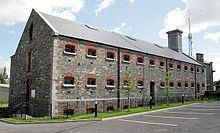Closed 1931 | County Louth Opened 1854 | |
 | ||
Location Carrickmacross RdDundalk, Similar St James' Church - Louth, Mountjoy Prison, Isle of Portland, Debden - Epping Forest, Withington | ||
Oriel cultural centre at dundalk gaol
Dundalk Gaol is a former gaol (prison) in Dundalk, County Louth, Ireland. The men's wing is now "The Oriel Centre", the women's wing is the Louth County Archive and the Governor's House now a Garda station.
Contents
- Oriel cultural centre at dundalk gaol
- Sophie coyle with s an bradley at dundalk gaol
- History
- 1922 Jailbreak
- Notable prisoners
- References
Sophie coyle with s an bradley at dundalk gaol
History
Built in 1853 to help with the overcrowding of the gaol already in place at Crow Street which is now Dundalk Town Hall. It was designed by John Neville and cost £23,000 to be constructed. The gaol was opened on the 19th January 1854. For approximately 60 years the Gaol functioned largely as an unremarkable county Gaol, averaging 25 prisoners at any one time, with few sentences of more than 2 years. During the 1870s it became the practice to send major offenders to a convict prison in Dublin, and a number of county Gaols were closed. This caused an overcrowding problem and a Royal Commission Report of 1877 recommended more prisons and even portable iron jails. Also Australia was refusing to accept any more Irish convicts. This led to the extension of prisons in Dublin and Spike Island, Cork. By 1915 the Gaol was not in use and was revived in 1918 to house IRA prisoners, including Stack, Treacy, Lynch etc. who embarked on short lived hunger strikes, were released and returned to their campaigns, without a great deal of attention. In 1922’23 the Gaol was swapped by the two Civil War parties back and forth and which led to some disturbances in Dundalk, reflected by some newspaper coverage, however, the major action took place in Dublin and Munster and the north east was relatively free from serious attrition, particularly as Aiken took only a minor role in the conflict. The Gaol closed again in 1925, and was closed by Ministerial Order in 1931 and subsequently occupied by the Garda Síochana. It ceased to function as a gaol in 1931 when it was closed by ministerial order. The Gardaí Síochána originally moved into the Governor's House in 1945 as a new police station, while Louth County Council used the existing yard as machinery and vehicle area and the cell buildings for storing office equipment, in 1991 the basement of the northern cellblock (male wing) was refurbished to serve as an National Emergency Centre for use by Louth Civil Defence.
1922 Jailbreak
On 27 July 1922, the Fourth Northern Division of the Irish Republican Army placed an explosive device on the wall of gaol along the Ardee road. Upon a signal from within, the device was detonated and exploded creating a sizeable hole in the wall.
